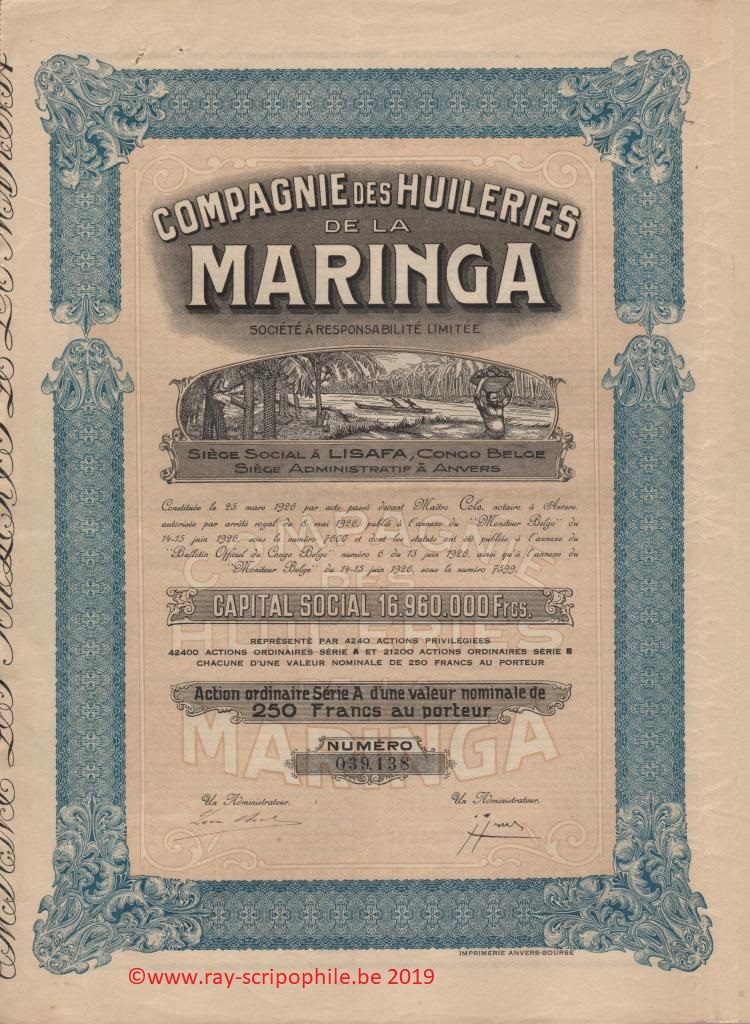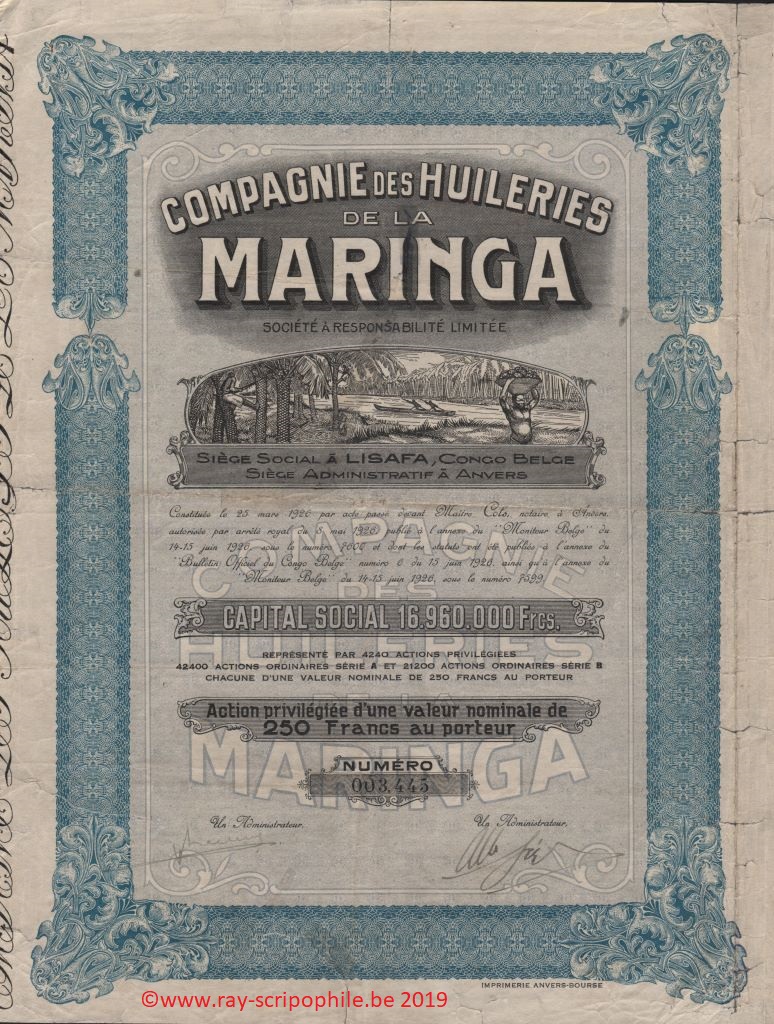Compagnie des Huileries de la Maringa S.R.L.
Constitution
The S.R.L. Compagnie des Huileries de la Maringa has been founded on March 25th, 1926. The head office has been established in Lisafa and the administrative office in Antwerp.
The share capital has been fixed at 16,960,000 francs and represented by 4,240 preference shares, 4,240 ordinary shares series A and 21,200 ordinary shares series B each with a nominal value of 250 francs.
The 4,240 preference shares and the 42,400 ordinary shares series A were subscribed by:
the Bank of Antwerp, 41,700 ordinary shares series A and 4,170 preference shares; the Compagnie du Congo Belge, Messrs. Léon Becker, Albert Seghers, John van der Taelen, Georges Geerts, Henri Leclercq, Baron Charles de t'Serclaes de Wommersom, each one hundred ordinary shares series A and ten preference shares.
All 21,200 ordinary shares series B were allocated to the Compagnie du Congo Belge plus a sum of 6,500,000 francs in remuneration of the contribution described below.
Note concerning the ordinary shares series B - For five consecutive financial years, when the shares series B will have received their first dividend of 7 p. c. in full, they will be, as from the closing of this fifth financial year, completely and definitively assimilated to the ordinary shares series A and put on the same footing and this in all respects.
From June 24 to July 6, 1926, the 4,240 preferred shares and the 42,400 ordinary shares series A were offered for subscription each at the price of 280 francs per share to the shareholders of the Compagnie du Congo Belge, on an irreducible basis only, at the rate of 1 preferred share per 100 shares of the Compagnie du Congo Belge and of 1 ordinary share series A per 10 shares of the Compagnie du Congo Belge (21-(1927 T3)-425/26).
Contribution(s)
The Compagnie du Congo Belge contributed several plots of land with a total area of 22,300 hectares.
The buildings and factories already erected on the land contributed, as well as the operating equipment, were included in the contribution. However, the Compagnie du Congo Belge had the right to choose, for a period of 5 years, various plots of land it had contributed. This option was given to it free of charge to enable it to erect commercial factories and transit warehouses on these plots. The total area of these plots cannot exceed one hundred hectares (21-(1927 T3)-425/26).
Board of Director
Directors
Laurent Meeus, Georges Geerts, Déon Becker, Henri Leclercq, Albert Seghers, Baron Charles de t'Serclaes de Wommersom, John Van der Taelen.
Commissioners
Mr. Amaury Carlier, René Maurice, Alfred Houtain, Joseph Verschueren (21-(1927 T3)-425/26).
Object
Forestry, agricultural, industrial, and mining exploitation of the lands brought by the Compagnie du Congo Belge, especially by developing the cultivation of the Elais palm tree, the erection of oil mills necessary for the processing of palm fruits, as well as all other factories necessary for these exploitations (21-(1927 T3)-425/26).
Change of capital, event(s), participation(s), dividend(s), cotation
The concessions were in the province of Equateur, in the basin of the navigable rivers Maringa and Lopori and included 5,000 hectares in Lisafa, 5,000 hectares in N'Deke, 12,000 hectares in Boiela, 12,000 hectares in Bongandanga, and three hundred hectares in Waka The estate of Waka is fully owned by the Company.
The Company started the development of the concessions of Lisafa, N'Deke, Boiela and Waka and expects to start the first works in Bongandanga during the next fiscal year. The main works conducted were the development of the palm groves and especially the establishment of roads for the transport of palm fruits to the factories and of the products to the various loading centers.
Two mechanical factories, one established in Lisafa that could process twenty tons of fruit per day, whose extraction began in October 1927, gave satisfaction; the other one set up in N'Deke, less sophisticated than the one in Lisafa, could process 4 to 5 tons of fruit per day. In Waka and Boiela, the extraction is done by means of hand presses.
For the first year, all efforts were directed towards the construction of roads and tracks. However, the production was 458,000 kilos of palm oil and 51,470 kilos of palm kernel. Of this production on June 30, 1927, 155,000 kilos of oil and 32,000 kilos of palm kernel were sold, which made it possible to depreciate the buildings, equipment, furniture, and barrels in the amount of 468,000 francs.
The first balance sheet established on June 30, 1927, could be considered as a balance sheet of first establishment (21-(1928 T1)-646/47).
The second fiscal year of 1927-28 was productive, with a production of 846,335 kilos of palm oil and 240,782 kilos of palm kernel (-(1929 T1)-680).
In the following years, the situation deteriorated due to the considerable drop in palm oil and palm kernel prices, the lack of indigenous staff to supply the fruit and the persistence of the world crisis.
It is only from the fiscal year 1934-35 that the situation improved with a result of the exploitation which amounted to a profit of 1,376,900 francs, less financial charges, and depreciation, giving a loss for this fiscal year of 250,638 francs in net decrease compared to the previous fiscal years (21-(1937 T1)-730).
See figures and prices below.


Merger
On July 5, 1937, the EGM decided to merge with the Compagnie du Congo Belge by contributing all its assets and liabilities to the latter.
The contribution of the Compagnie des Huileries de la Maringa was realized as follows
a) handing over to the Compagnie des Huileries de la Maringa of 42,400 new fully paid-up shares of the Compagnie du Congo Belge, dividend date January 1, 1937.
b) simple cancellation of the 21,200 ordinary shares series B of the absorbed company, being in the portfolio of the Compagnie du Congo Belge.
c) reimbursement at their nominal value of 250 francs of the 4,240 preferred shares of the absorbed company, these securities being cancelled without any other counter value than this reimbursement.
Through this merger, the capital of the Compagnie du Congo Belge was increased to 41,800,000 francs by the creation of 42,400 shares, the capital was then represented by 466,000 shares without value designation (30-(1937)-836 à 42).



